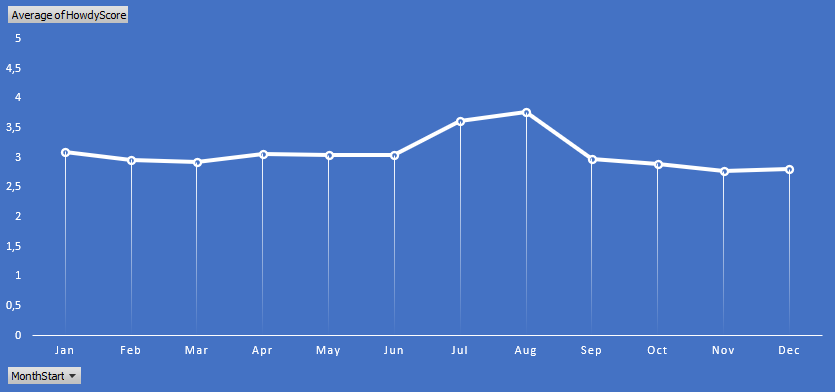You may already be aware that people, including your employees, can be affected by the “winter blues”. The general mood seems to go down as the weather gets colder; everyone is tired. As we move into the fall and winter in northern Europe, you may find that it is hard, as a manager, to keep productivity up.
Here, we will review what the research – including our own HowdyData – shows about mental health during different seasons and discuss what you can do to maintain employee wellbeing all year round.
How Can the Seasons Affect Your Mood and Wellbeing?
Mental health experts agree that the changing seasons can significantly affect our mental health, mood, and overall wellbeing. Generally, people tend to experience a decline in their overall mental health during the winter months.
There are some practical reasons, why employee mental health may take a hit during the winter months. [1]
- Reduced sunlight: This is the most cited reason for poor mental health in the winter. Winter is dark, and in some northern countries, the sun may barely come out at all. Studies have found that this lack of natural sunlight can have an impact on hormone levels that affect mood – for example, on Vitamin D levels.
- Lack of movement: Winter is also cold. This means that many people may be less likely to have the energy or motivation to be active. Regular physical activity is a key component of both physical and mental health, and exercising less in the winter could contribute to depression symptoms.
- Disrupted sleep: Lack of sunlight can also affect melatonin production, which affects the sleep cycle and circadian rhythm. Not getting enough sleep at night or having a disrupted sleep cycle can contribute to symptoms of depression and anxiety.
- Holiday loneliness: Some people feel lonely during the winter holidays. Grief about past loved ones could feel especially overwhelming during this time.
According to Howdy’s chief psychologist, Mette Nørgaard Nielsen, work-life balance also affects mental health during the winter months.
“Howdy’s response team hears directly from employees that their wellbeing is affected by the challenging balance between their workload and the opportunities they have to relax and recharge during the winter. Many employees experience a higher workload and faster pace in the fall and winter. They also have fewer days off compared to the spring and summer,” Nielsen explains.
“In other words, in the winter we get less of the things that recharge our batteries – things like sunlight and being physically active – than we do in the summer. That means we’re all running around with lower battery levels, while also being busier. It’s natural that our mood would take a hit during the darker months.”
What is Seasonal Affective Disorder?
Some people experience such severe mood changes during the winter that they may be diagnosed with seasonal affective disorder (SAD). SAD is a depressive disorder that often requires treatment. [1] SAD is more prevalent in countries that get darker during the winter months, like the Northern parts of Europe.
However, it is important to realise that people do not need to meet the diagnostic criteria of SAD to experience mood changes with the seasons. As our data shows, most people experience the “winter blues” – a dip in mood during the winter that may not reach levels of a clinically diagnosed depression but can be still uncomfortable.
In other words, even if your employees are not clinically depressed, these seasonal changes are still important to pay attention to. Regardless of whether they need to be diagnosed with a mental health condition, it is critical to know how to support all employees, especially when they feel down and less productive in the winter.
Howdy’s Data Reveals: Mental Health Decreases in Autumn
Our Howdy Wellbeing data corroborates mental health experts’ claims: people tend to experience a more sombre mood and an overall decline in mental health during the winter months, whereas, during the summer, there’s a marked shift towards a more energised and uplifted state.
Using our 5-point scale, employees rated themselves, on average at 3.61 in July and 3.76 in August. The average HowdyScore across all 12 months is 3.06 – making it clear that employees are generally much happier in the summer.
SCORE BY SEASON

On the other hand, HowdyData reveals that employees are faced with a dip in their mental health during the colder months. The first big dip comes in September, with the average HowdyScore dropping from 3.76 (in August) to 2.9 within one month. The month when employees feel at their lowest is November.
Considering the whole year, one can see that the Howdy score stabilises during the winter holidays with a small, short peak after New Year and a decline in February below 3.0, before it slowly improves in the summer months July and August.
Nielsen has some theories as to why the HowdyData indicates such a significant decrease in mental health during the fall and winter.
“Our theory is that the summer holidays are the main factor here. When we have time off from work – especially in the summer – we spend more time outside, get more sunlight, and have a chance to see people and do things that make us happy. We may not prioritise these important activities as much during busy workdays,” Nielsen says. “When we return to work in the fall, we go straight back into a never-ending list of tasks and a fast workpace, which can feel overwhelming.”
What can Employers Do to Enhance Employees’ Wellbeing?
Employers play an important role in ensuring that employee mental health is taken care of throughout the year, especially during seasons when their mood may be low.
Monitor Employee Mental Health
One of the most important things you can do to support employee mental health is to be aware of what your employees need and when. We have presented you with the data that we have compiled across all of Howdy’s partners. But your organisation needs to know how your employees are doing each month.
Howdy makes it easy for you to know exactly what is going on with your employees. Howdy measures employee wellbeing on a regular basis and gives you valuable insight into how your team is really feeling.
Pay especially close attention to these scores during times of the year in which the seasons are changing – the days are getting longer or shorter, or the temperature is changing. These are times when you may notice downward (or upward) trends in your employees’ mental wellbeing.
Create Opportunities for Physical and Outdoors Activities
One of the main reasons, why mental wellbeing may drop during months with extreme temperatures (like winter or summer) is that people may be exercising less and spending less time outdoors. It can be difficult to feel motivated to exercise, when it feels too hot or cold outside, which is understandable – but physical activity is one of the best things we can do for our overall mental health.
When weather permits, find opportunities to invite your employees to move their bodies or get some sunlight. For example, you can take walk-and-talk meetings rather than having every meeting in a dark office. Open the window blinds to let in more natural light.
In addition, our HowdyBody tool measures employees’ overall physical health and suggests ways on how employees can move their bodies in healthy ways. The module includes a full range of exercises divided by body parts; each body part has seven core exercises: Warm-up, Coordination, Mobility, Stretching, Stability, Strength, and Balance.
When our advanced algorithms detect a high pain level, our response team will proactively call the employee before the pain gets too severe. Employees now have also the option to talk with a physiotherapist, even with mild to moderate pain levels.
Communicate about Available Benefits
Many organisations offer employee benefits for mental health – but these benefits go unused because nobody knows about them. You can combat this by taking steps to ensure that every one of your employees knows about the mental health benefits that are available to them.
Remind your employees of every mental health service they have access to. It may not be enough to remind them once a year – take the extra time to talk to your employees about these benefits, especially during the winter months when overall mental health may be low.
With Howdy, you can rest assured that your team will receive the intervention they need when they need it. Howdy’s response team will proactively call any employee who seems to be taking a hit to their mental health – providing early detection, proactive care, and reduced burnout and sick leave.
References:
- Melrose, S. (2015). Seasonal affective disorder: An overview of assessment and treatment. Depression Research and Treatment.
- Substance Abuse and Mental Health Services Administration. Seasonal Affective Disorder (SAD). https://www.samhsa.gov/mental-health/seasonal-affective-disorder
- National Library of Medicine. Seasonal affective disorder. https://medlineplus.gov/genetics/condition/seasonal-affective-disorder/


